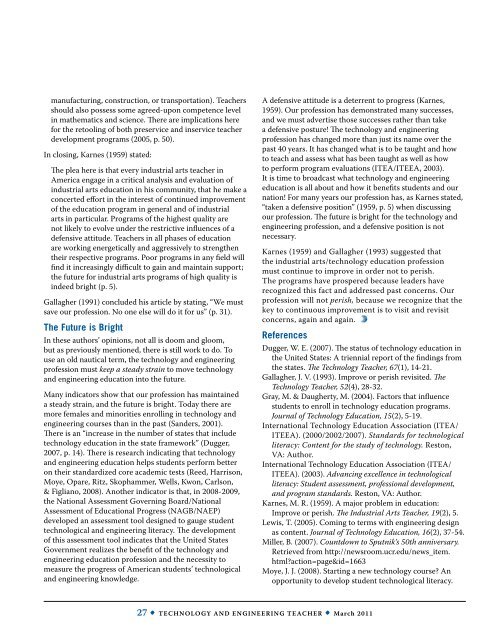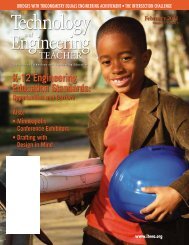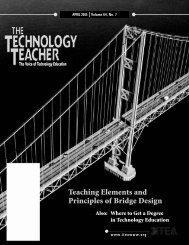March - Vol 70, No 6 - International Technology and Engineering ...
March - Vol 70, No 6 - International Technology and Engineering ...
March - Vol 70, No 6 - International Technology and Engineering ...
You also want an ePaper? Increase the reach of your titles
YUMPU automatically turns print PDFs into web optimized ePapers that Google loves.
manufacturing, construction, or transportation). Teachers<br />
should also possess some agreed-upon competence level<br />
in mathematics <strong>and</strong> science. There are implications here<br />
for the retooling of both preservice <strong>and</strong> inservice teacher<br />
development programs (2005, p. 50).<br />
In closing, Karnes (1959) stated:<br />
The plea here is that every industrial arts teacher in<br />
America engage in a critical analysis <strong>and</strong> evaluation of<br />
industrial arts education in his community, that he make a<br />
concerted effort in the interest of continued improvement<br />
of the education program in general <strong>and</strong> of industrial<br />
arts in particular. Programs of the highest quality are<br />
not likely to evolve under the restrictive influences of a<br />
defensive attitude. Teachers in all phases of education<br />
are working energetically <strong>and</strong> aggressively to strengthen<br />
their respective programs. Poor programs in any field will<br />
find it increasingly difficult to gain <strong>and</strong> maintain support;<br />
the future for industrial arts programs of high quality is<br />
indeed bright (p. 5).<br />
Gallagher (1991) concluded his article by stating, “We must<br />
save our profession. <strong>No</strong> one else will do it for us” (p. 31).<br />
The Future is Bright<br />
In these authors’ opinions, not all is doom <strong>and</strong> gloom,<br />
but as previously mentioned, there is still work to do. To<br />
use an old nautical term, the technology <strong>and</strong> engineering<br />
profession must keep a steady strain to move technology<br />
<strong>and</strong> engineering education into the future.<br />
Many indicators show that our profession has maintained<br />
a steady strain, <strong>and</strong> the future is bright. Today there are<br />
more females <strong>and</strong> minorities enrolling in technology <strong>and</strong><br />
engineering courses than in the past (S<strong>and</strong>ers, 2001).<br />
There is an “increase in the number of states that include<br />
technology education in the state framework” (Dugger,<br />
2007, p. 14). There is research indicating that technology<br />
<strong>and</strong> engineering education helps students perform better<br />
on their st<strong>and</strong>ardized core academic tests (Reed, Harrison,<br />
Moye, Opare, Ritz, Skophammer, Wells, Kwon, Carlson,<br />
& Figliano, 2008). Another indicator is that, in 2008-2009,<br />
the National Assessment Governing Board/National<br />
Assessment of Educational Progress (NAGB/NAEP)<br />
developed an assessment tool designed to gauge student<br />
technological <strong>and</strong> engineering literacy. The development<br />
of this assessment tool indicates that the United States<br />
Government realizes the benefit of the technology <strong>and</strong><br />
engineering education profession <strong>and</strong> the necessity to<br />
measure the progress of American students’ technological<br />
<strong>and</strong> engineering knowledge.<br />
A defensive attitude is a deterrent to progress (Karnes,<br />
1959). Our profession has demonstrated many successes,<br />
<strong>and</strong> we must advertise those successes rather than take<br />
a defensive posture! The technology <strong>and</strong> engineering<br />
profession has changed more than just its name over the<br />
past 40 years. It has changed what is to be taught <strong>and</strong> how<br />
to teach <strong>and</strong> assess what has been taught as well as how<br />
to perform program evaluations (ITEA/ITEEA, 2003).<br />
It is time to broadcast what technology <strong>and</strong> engineering<br />
education is all about <strong>and</strong> how it benefits students <strong>and</strong> our<br />
nation! For many years our profession has, as Karnes stated,<br />
“taken a defensive position” (1959, p. 5) when discussing<br />
our profession. The future is bright for the technology <strong>and</strong><br />
engineering profession, <strong>and</strong> a defensive position is not<br />
necessary.<br />
Karnes (1959) <strong>and</strong> Gallagher (1993) suggested that<br />
the industrial arts/technology education profession<br />
must continue to improve in order not to perish.<br />
The programs have prospered because leaders have<br />
recognized this fact <strong>and</strong> addressed past concerns. Our<br />
profession will not perish, because we recognize that the<br />
key to continuous improvement is to visit <strong>and</strong> revisit<br />
concerns, again <strong>and</strong> again.<br />
References<br />
Dugger, W. E. (2007). The status of technology education in<br />
the United States: A triennial report of the findings from<br />
the states. The <strong>Technology</strong> Teacher, 67(1), 14-21.<br />
Gallagher, J. V. (1993). Improve or perish revisited. The<br />
<strong>Technology</strong> Teacher, 52(4), 28-32.<br />
Gray, M. & Daugherty, M. (2004). Factors that influence<br />
students to enroll in technology education programs.<br />
Journal of <strong>Technology</strong> Education, 15(2), 5-19.<br />
<strong>International</strong> <strong>Technology</strong> Education Association (ITEA/<br />
ITEEA). (2000/2002/2007). St<strong>and</strong>ards for technological<br />
literacy: Content for the study of technology. Reston,<br />
VA: Author.<br />
<strong>International</strong> <strong>Technology</strong> Education Association (ITEA/<br />
ITEEA). (2003). Advancing excellence in technological<br />
literacy: Student assessment, professional development,<br />
<strong>and</strong> program st<strong>and</strong>ards. Reston, VA: Author.<br />
Karnes, M. R. (1959). A major problem in education:<br />
Improve or perish. The Industrial Arts Teacher, 19(2), 5.<br />
Lewis, T. (2005). Coming to terms with engineering design<br />
as content. Journal of <strong>Technology</strong> Education, 16(2), 37-54.<br />
Miller, B. (2007). Countdown to Sputnik’s 50th anniversary.<br />
Retrieved from http://newsroom.ucr.edu/news_item.<br />
html?action=page&id=1663<br />
Moye, J. J. (2008). Starting a new technology course? An<br />
opportunity to develop student technological literacy.<br />
27 • <strong>Technology</strong> <strong>and</strong> <strong>Engineering</strong> Teacher • <strong>March</strong> 2011
















